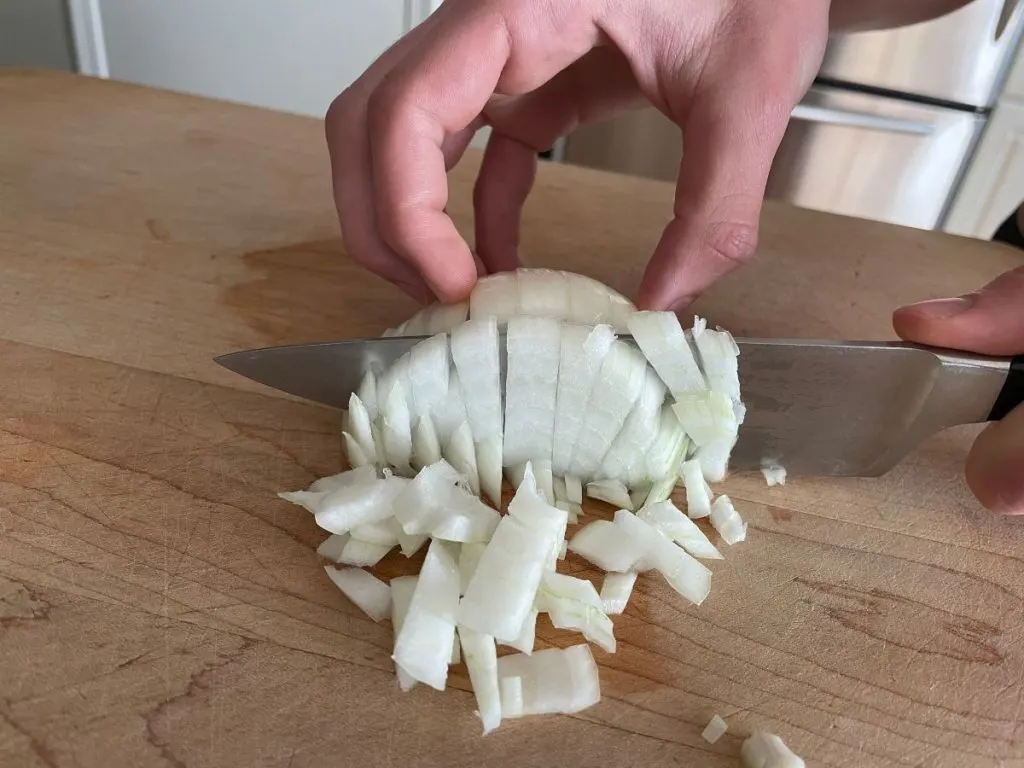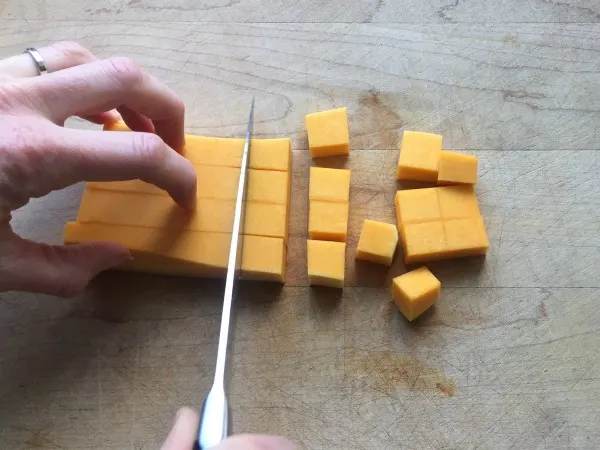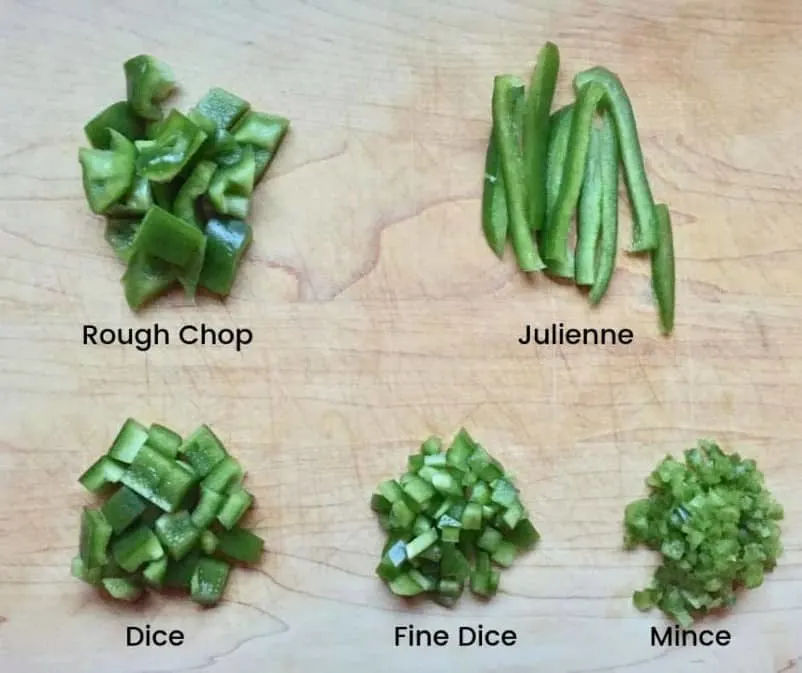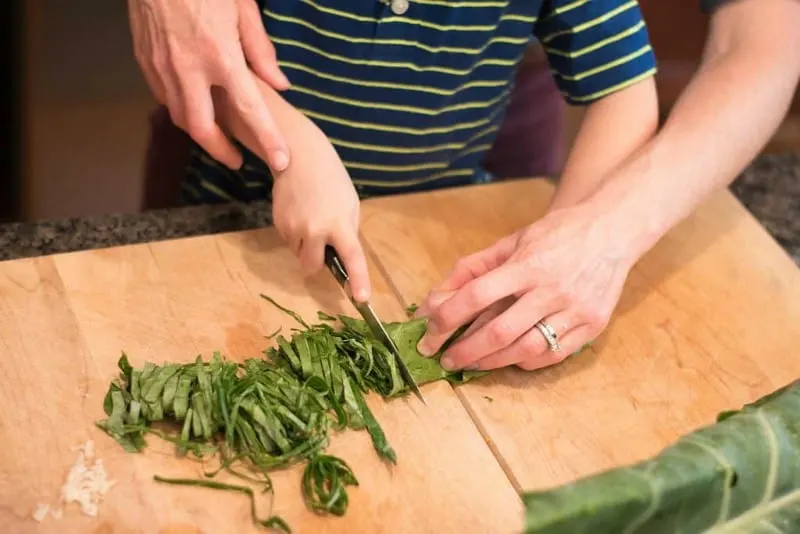Whether you’re just learning how to cook or are looking for ways boost your skills and improve your efficiency in the kitchen, faster chopping is one of the most effective ways that you can save time. But for some people, using a sharp knife is one of the most intimidating parts of the process, so I wanted to share information that will give you confidence, save you time, and keep you safer when it comes to chopping.

Note: This page contains affiliate links. If you purchase a product through these links, your cost will be the same but The Scramble will receive a small commission. I only link to products I personally use, trust, and love. If you want to learn more, please check out my disclosure page. Thanks for your support!
How to Use a Kitchen Knife
One of the most important keys to faster chopping is having good knife skills. Using knives properly will help you to feel more in control, be safer, and move faster when you are chopping up food.
Use a Proper Grip
When holding your knife, make sure that your whole hand is on the handle, behind the bolster (that’s the part of the knife where the blade ends and the handle begins). This is called the handle grip.
Once you get more comfortable, you can also choose to use a blade grip, which is when your thumb goes on one side of the blade and your tucked in index finger goes on the other side and touches the bolster. The blade grip will give you a bit more control, but should only be used once you feel confident.
Claw Grip
Whenever you’re holding food in place and moving the knife down the food towards your fingers, keep your fingertips tucked under and hold the food with a “claw grip.” This will protect your fingertips and give you more control.
Get to Flat
No matter what food you’re chopping, whenever possible make the first step in your chopping journey be to create a flat side. Once you have that flat side, you’ll be able to keep the food much more stable, which will make everything go more smoothly.
What Do Different Chopping Terms Mean?
Another key to faster chopping and efficient cooking overall is being clear on what you are trying to do. So, knowing what different chopping terms mean can be very helpful, especially since understanding the sometimes-subtle differences between chopped, finely chopped, diced, and minced can be tricky. The chopping definitions, in order of size of the final product, go this way:
Julienne: This is when you cut food into very thin, matchstick-shaped pieces.
Rough Chop: This is the largest and most forgiving of chopping styles. The pieces don’t need to be very consistent, it is mostly about just taking the larger item and turning it into smaller pieces.
Chop: This means things just need to be made smaller but not necessarily perfectly even. Usually about 1/4-1/3 inch across.
Dice: Try to make the pieces more uniform and smaller than a chop, usually between 1/8-1/4 inch across.
Finely Dice: This is between dicing and mincing, so pretty small.
Mince: This is when you chop or grate into tiny pieces.
 Tips for Faster Chopping
Tips for Faster Chopping
Here are some other suggestions that might make your knife work go a little more quickly:
Make sure you have good quality knives
There are two factors to take into account when determining if your knife is a good quality knife:
- does it feel balanced and comfortable in your hand when you’re chopping?
- does it keep its edge well (i.e., does it stay sharp for a week or more of regular chopping)?
If the answer either of these questions is no, then it is time to think about buying some better knives. I recommend that you check out my list of the four knives I think everyone should have in their kitchen or at least take a peak at my absolute favorite knife, which I have used for 20 years and doesn’t cost an arm and a leg.
In addition, a good pair of kitchen shears, like these ones which I really love, can also make easier work of cutting herbs, scallions, and other delicate foods.
Make sure your knives are sharp
There are two reasons to make sure your knives are sharp: efficiency and safety.
A sharp knife will cut through food more efficiently for two reasons:
- you won’t need to go back and re-cut
- you won’t need to position everything as carefully to get a solid cut in the first place
In addition, a dull knife is much more dangerous because it’s more likely to roll out and cut you.
To see if your knife is sharp, turn it blade-side up and see if any light reflects off the blade. Wherever you see light reflect back is a spot where there is a chink in the metal that needs to be sharpened out.
How to sharpen knives
But how do you sharpen knives? First, I recommend that you take your knives to be sharpened by a professional at least once a year. Most hardware stores offer this service as do some craft stores, such as Joann Fabrics.
In between those professional sharpenings, I recommend using an at-home sharpener every week or two. After trying many different sharpening tools, I found that this one was the easiest and most effective to use. I use mine every week or two, just to keep my knives in tip-top shape.
Use a cutting board
Chopping your food on a cutting board is more efficient than cutting on the counter top or plate. This is for a few reasons: 1) cutting on a counter top or plate is terrible for your knives and will dull them very quickly (see above about the importance of sharp knives) and 2) chopping on a cutting board makes it easier to comfortably contain and transport your piles of chopped food (a plate will be too small, causing you to waste time maneuvering the food around, plus it’s bad for your knives).
While you can use plastic cutting boards, the wood or bamboo ones are easier on your knives and also more sanitary (yucky bacteria is less likely to get trapped in the microcuts a knife will naturally leave on the cutting board).
A bonus tip: If you find that the cutting board slides around on your counter, put a dishtowel underneath to stabilize it.

Cut through multiple vegetables or layers at once
This may sound daunting if you’re just becoming comfortable with chopping, but if you take the time to line things up, you will find that chopping does much faster. For example, lining up carrots or green beans side-by-side or stacking onion slices so you can cut through several at once will save you precious minutes as you race to get dinner on the table.
Tip down
When chopping smaller vegetables, garlic, and herbs, keep the tip of your chef’s knife in contact with the cutting board and keep your hand on the top (not sharp) edge of the knife to direct it.
Using the food processor is NOT cheating
For big fine dicing or mincing jobs, you might want to consider using a food processor as it can whiz right through vegetables in seconds flat (if you are in need of a good food processor, I’ve been using my Cuisinart for 20 years and it’s still going strong!)
Using pre-prepped ingredients isn’t cheating
For example, using minced garlic and pre-shredded carrots and cheeses can save you time and effort. It’s a trade off between the value of your time vs. money.
Check out our Library of How Tos
We’ve created a collection of demo videos of how to chop many common ingredients such as onions, garlic, belle peppers, avocados, and more in the most efficient ways possible.
Take a class
If you really want to up your chopping game or feel the need for more guidance, you might also consider taking a knife skills class at a local cooking school. The skills you learn will pay off nightly in your kitchen.
Watch the video to learn the 3 knives you REALLY need, how to use them to cut onions, tomatoes, and other vegetables efficiently and safely, and how to sharpen them in seconds:
I hope this guidance on faster chopping and chopping terms will help make your dinner preparation even speedier, and please let me know below or on The Scramble Facebook page if you have any other questions or suggestions. If you want additional help with meal preparation, sign up for The Scramble’s family-friendly meal plans so you can see how simple planning, easy cooking, and joyful eating can be!


 Tips for Faster Chopping
Tips for Faster Chopping
Santoku vs Gyuto knives-Which one is better?
Monday 16th of January 2023
[…] knives have shorter blades and thicker blades, so they are best suited to heavy work like chopping, slicing, and […]
Cooking Terminology in English – Oxford Institute Education
Thursday 24th of November 2022
[…] To cut food into very small (1/8 to ¼-inch) cubes. For a more extensive explanation of chopping terms and styles, including visual guides, go here. […]
Your Guide to Medellin Cooking Classes - Casacol
Sunday 9th of October 2022
[…] were in a professional kitchen and learning a variety of techniques to chop better and cook food more efficiently! Although not a “Colombian” experience, we did drastically […]
Need More Hours in Your Day? Ten Kitchen Time-Savers that Can Help
Tuesday 25th of August 2020
[…] A good pair of kitchen scissors can also make easier work of cutting herbs, scallions and other foods. Check out The Scramble Store to see some of our favorites and make sure to explore our tips on how to to chop quickly and efficiently. […]
The Knives you Need to Make Chopping and Food Prep Easy
Thursday 13th of August 2020
[…] Finally, knowing how to use your knives efficiently and safely is essential. For tips and suggestions on this, check out my post packed with chopping advice. […]